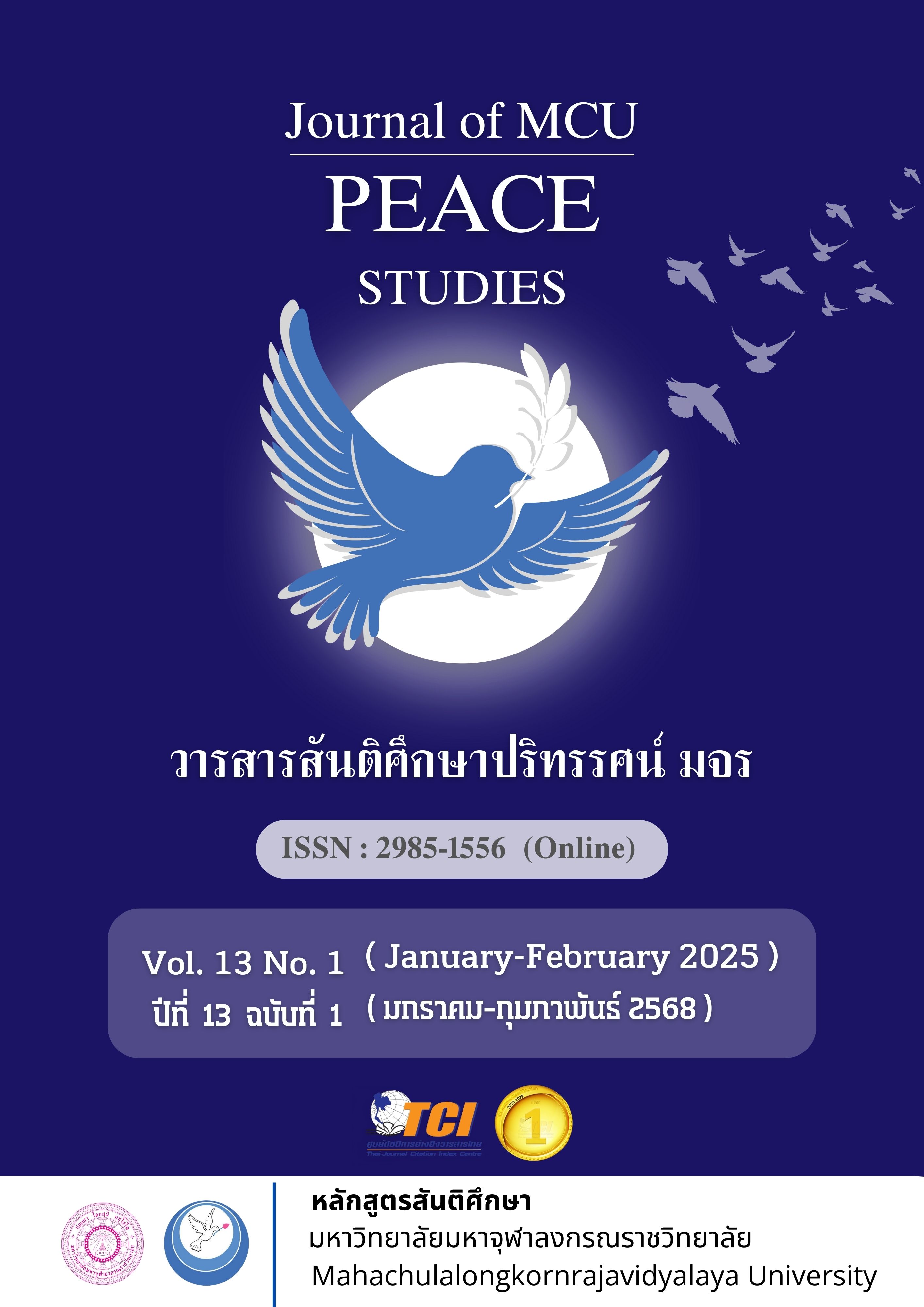Buddhism Intergrated with Social Work Practice
Main Article Content
Abstract
This research aims to 1) Study Buddhist principles applied in social work practicum, 2) Investigate methods of integrating Buddhist principles with social work, 3) Propose guidelines for integrating practicum in the Bachelor of Social Work program at Mahamakut Buddhist University. This research is a mixed-method research. The population used in the study is Social Work students of Mahamakut Buddhist University students from the Social Work program at Mahamakut Buddhist University (Main campus and Isan campus) enrolled in Practicum 1, Practicum 2, and Practicum of 3 courses. By collecting data on every person, instructors, and field advisors, total 77 person.
The research results found that: 1. The use of Buddhist principles Sappurisadhamma 7 in all aspects was at the highest level in the practicum, especially Kalanutthana (knowing the proper time), Mattanutthana (knowing moderation), Dhammantthana (knowing the reasons), Attanutthana (knowing oneself), Puggalanutthana (knowing individuals), Atthanutthana (knowing the goal), and Parisanutthana (knowing the community), respectively. 2. Students integrated Buddhist principles with social work to a great extent in terms of basic work knowledge, techniques, attitudes, skills, and social work service principles. 3. Concerning the integration guidelines for Buddhist principles in social work practicum, students rated instructor integration highest, followed by student integration, curriculum, and practicum agency, respectively.
Article Details

This work is licensed under a Creative Commons Attribution-NonCommercial-NoDerivatives 4.0 International License.
Views and opinions expressed in the articles published by The Journal of MCU Peace Studies, are of responsibility by such authors but not the editors and do not necessarily reflect those of the editors.
References
Announcement of the Social Work Professional Council regarding the Standards of service for Social Work Professionals B.E. 2564 (2021, June 30). Royal Gazette. Volume 138, Special Section 144.
Association of Experiential Education (AEE). 2003. Definition of Experiential Education. Retrieved February 5, 2016, from https://www.aee.orgndef.html
Bachelor of Social Work Program in Social Work. (2020). Faculty of Social Sciences. Nakhon Pathom: Mahamakut Buddihist University.
Boonyarattanasoontorn, J., Kumhom, R., Kammanat, Y., & Kamdang, Th. (2021). Creating Value and Core Competencies of Professional Social Workers. Journal of Social Work, 29(1), 294-328.
Chaiyaphan, T. (2017). An Application of Buddhadhamma for Promoting Administrative Effectiveness in Local Administrative Organizations in Ubon Ratchatani Province. (Doctoral Dissertation). Mahachulalongkornrajavidyalaya University. Ayutthaya.
Chankhiaw, S. (2016). Learning Management on Buddhism through Integrated Buddhist Methods. CMRU Ganesha Journal, 12(1), 15-27.
Course Professor Central 1. (2023). Professor. Interview. June, 10.
Detophat, Y. (2022). Application of the Buddhist Principle of Suppurisadhamma by School Administrators Affecting the Happiness in the Workplace at Schools under Rayong Primary Educational Service Area Office 2. (Master’s Thesis). Rambhai Barni Rajabhat University. Chanthaburi.
Dockthaisong, B., Raksamueng, S., & Maharattanasakul, p. (2017). The Integrative Buddhism Principles to Read the Profound Public Administration to Build the Mahachulalongkornrajavidyalaya Intelectual Capital through Higher Learning and Ready Toward AEC. Journal of MCU Social Science Review, 6(2), 69-84.
Jedsadawiroj, S. (2003). The Integration of Teaching and Learning Management. Bangkok: Book Point Company Limited.
Khammani, T. (2005). Teaching Science: Knowledge for Organizing Effective Learning Process. (4th ed.). Bangkok: Dansuttha Printing Company.
Kumhom, R. (2013). The Principle and Processes of Micro Social Work Practice. (2nd ed.). Bangkok: Thammasat University Press.
Lappin, E. (2000). Outdoor Education for Behavior Disturbed Student. Washington, D. C.: ERIC Digest.
Ministry of Education. (2010). National Education Ace off 1999, Amended (No 2) B.E. 2022 and (No 3) B.E. 2010. Bangkok: Printing House Transport Organization and Parcel.
Parimethachai, P. (2022). BuddhaDhamma Integration for Human Resource Development of the Office of Contemporary Art and Culture. (Doctoral Dissertation). Mahachulalongkornrajavidyalaya University. Ayutthaya.
Phra Dhammakosajarn (Prayoon ThammaJitto). (2009). The Method of Integrating Buddhism with Modern Sciences. Ayuthaya: Mahachulalongkornrajavidyalaya University Press.
Phra Promwihan Athidhammo (Daendongying). (2021). The Desirable Characteristics of the Local Politicians in Khon Kaen Municipality. (Master’s Thesis). Mahachulalongkornrajavidyalaya University University. Ayutthaya.
Podapol, P., & Podapol,p. (2020). Application of Administrative Principle on Suppurisa-Dhamma to Administration of Sub-District Administrative Organizations in Phon Thong District, Roi Et Province. Journal of Srilanchang Review, 6(2), 83-93.
Practical Training Students 1 Isan Campus. Student. Interview. May, 23.
Practical Training Students 2 Central Campus. Student. Interview. June, 20.
Practical Training Students 2 Isan Campus. Student. Interview. May, 23.
Practical Training Students 3 Isan Campus. Student. Interview. May, 23.
Priest, S. (1990). The Semantics of Adventure Education. In Miles, J. C. & Priest, S. (Eds.). Adventure Education (pp. 113-117). State College, PA: Venture Publishing.
Suknaisith, A. (2021). Learning Management Outside the Classroom to Develop Project Evaluation Skills for of Bachelor of Arts Program Students Research Field in Sociology for the Development. Research and Development Institute Journal of Chaiyaphum Rajabhat University, 3(2), 84-95.

